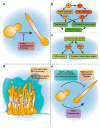Linking Cellular Morphogenesis with Antifungal Treatment and Susceptibility in Candida Pathogens
- PMID: 30795580
- PMCID: PMC6463059
- DOI: 10.3390/jof5010017
Linking Cellular Morphogenesis with Antifungal Treatment and Susceptibility in Candida Pathogens
Abstract
Fungal infections are a growing public health concern, and an increasingly important cause of human mortality, with Candida species being amongst the most frequently encountered of these opportunistic fungal pathogens. Several Candida species are polymorphic, and able to transition between distinct morphological states, including yeast, hyphal, and pseudohyphal forms. While not all Candida pathogens are polymorphic, the ability to undergo morphogenesis is linked with the virulence of many of these pathogens. There are also many connections between Candida morphogenesis and antifungal drug treatment and susceptibility. Here, we review how Candida morphogenesis-a key virulence trait-is linked with antifungal drugs and antifungal drug resistance. We highlight how antifungal therapeutics are able to modulate morphogenesis in both sensitive and drug-resistant Candida strains, the shared signaling pathways that mediate both morphogenesis and the cellular response to antifungal drugs and drug resistance, and the connection between Candida morphology, drug resistance, and biofilm growth. We further review the development of anti-virulence drugs, and targeting Candida morphogenesis as a novel therapeutic strategy to target fungal pathogens. Together, this review highlights important connections between fungal morphogenesis, virulence, and susceptibility to antifungals.
Keywords: Antifungal drug resistance; Antifungal drugs; Candida; Fungal morphogenesis; Fungal pathogens.
Conflict of interest statement
The authors declare no conflict of interest.
Figures

References
-
- Doi A.M., Pignatari A.C.C., Edmond M.B., Marra A.R., Camargo L.F.A., Siqueira R.A., da Mota V.P., Colombo A.L. Epidemiology and microbiologic characterization of nosocomial candidemia from a Brazilian national surveillance program. PLoS ONE. 2016;11:e0146909. doi: 10.1371/journal.pone.0146909. - DOI - PMC - PubMed
Publication types
Grants and funding
LinkOut - more resources
Full Text Sources

